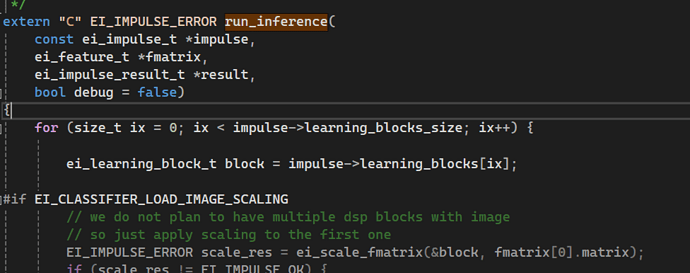Hi,
I am currently trying to increase the number of raw data in features so I am able to classify more data instead of a single set each time. Any advice or solution to doing so? Thank you!
Hi @FYPGabriel
You are doing this in Zephyr right ? Whooo!
You’ll want to work with run_classifier_continuous()
- run_classifier_continuous() - Retains a sliding window of features so that inference may be performed on a continuous stream of data. We will not explore this option in this tutorial.
Out of curiosity what board are you working with?
Best
Eoin
Hey Eoin,
I am doing it on Zephyr as youve said! Working on the NRD52840-DK board. Thanks for the suggestion, I will give the run_classifer_continuous() a look through
Best Regards,
Gabriel
What if my input data does not depend on any time series, how do i go about classifying raw data 1, raw data 2… raw data x?
Hi @FYPGabriel
Ah right in that case just use the original run_inference function and customise to batch process an array of features:
https://unstop.com/blog/2d-array-in-cpp
I recommend following Shawns tutorial on C++
Best
Eoin
Hi @Eoin,
May I ask what is the impulse parameter and what should be included for the run_inference function?
Best Regards,
Gabriel
This is the main.cpp that i am currently using, hope it helps!
// Zpehyr 3.1.x and newer uses different include scheme
#include <version.h>
#if (KERNEL_VERSION_MAJOR > 3) || ((KERNEL_VERSION_MAJOR == 3) && (KERNEL_VERSION_MINOR >= 1))
#include <zephyr/kernel.h>
#else
#include <zephyr.h>
#endif
#include "edge-impulse-sdk/classifier/ei_run_classifier.h"
#include "edge-impulse-sdk/dsp/numpy.hpp"
#include <nrfx_clock.h>
static const float features[] = {
6.8047, 15.0982, 22.1960, 1.2526, -3.2098, -4.2553
// copy raw features here (for example from the 'Live classification' page)
// see https://docs.edgeimpulse.com/docs/running-your-impulse-locally-zephyr
};
int raw_feature_get_data(size_t offset, size_t length, float *out_ptr) {
memcpy(out_ptr, features + offset, length * sizeof(float));
return 0;
}
int main() {
// This is needed so that output of printf is output immediately without buffering
setvbuf(stdout, NULL, _IONBF, 0);
#ifdef CONFIG_SOC_NRF5340_CPUAPP
// Switch CPU core clock to 128 MHz
nrfx_clock_divider_set(NRF_CLOCK_DOMAIN_HFCLK, NRF_CLOCK_HFCLK_DIV_1);
#endif
printk("Edge Impulse standalone inferencing (Zephyr)\n");
if (sizeof(features) / sizeof(float) != EI_CLASSIFIER_DSP_INPUT_FRAME_SIZE) {
printk("The size of your 'features' array is not correct. Expected %d items, but had %u\n",
EI_CLASSIFIER_DSP_INPUT_FRAME_SIZE, sizeof(features) / sizeof(float));
return 1;
}
ei_impulse_result_t result = { 0 };
while (1) {
// the features are stored into flash, and we don't want to load everything into RAM
signal_t features_signal;
features_signal.total_length = sizeof(features) / sizeof(features[0]);
features_signal.get_data = &raw_feature_get_data;
// invoke the impulse
EI_IMPULSE_ERROR res = run_classifier(&features_signal, &result, true);
printk("run_classifier returned: %d\n", res);
if (res != 0) return 1;
printk("Predictions (DSP: %d ms., Classification: %d ms., Anomaly: %d ms.): \n",
result.timing.dsp, result.timing.classification, result.timing.anomaly);
#if EI_CLASSIFIER_OBJECT_DETECTION == 1
bool bb_found = result.bounding_boxes[0].value > 0;
for (size_t ix = 0; ix < result.bounding_boxes_count; ix++) {
auto bb = result.bounding_boxes[ix];
if (bb.value == 0) {
continue;
}
printk(" %s (%f) [ x: %u, y: %u, width: %u, height: %u ]\n", bb.label, bb.value, bb.x, bb.y, bb.width, bb.height);
}
if (!bb_found) {
printk(" No objects found\n");
}
#else
for (size_t ix = 0; ix < EI_CLASSIFIER_LABEL_COUNT; ix++) {
printk(" %s: %.5f\n", result.classification[ix].label,
result.classification[ix].value);
}
#if EI_CLASSIFIER_HAS_ANOMALY == 1
printk(" anomaly score: %.3f\n", result.anomaly);
#endif
#endif
k_msleep(2000);
}
}


